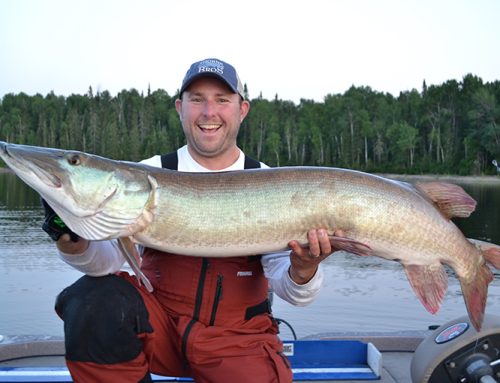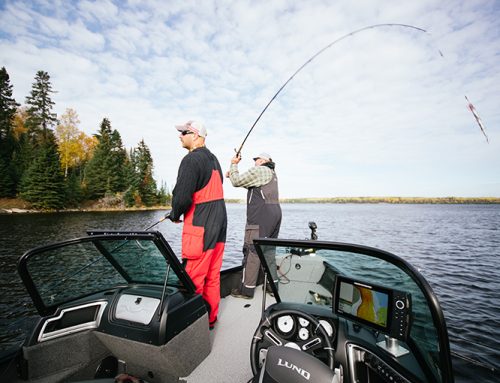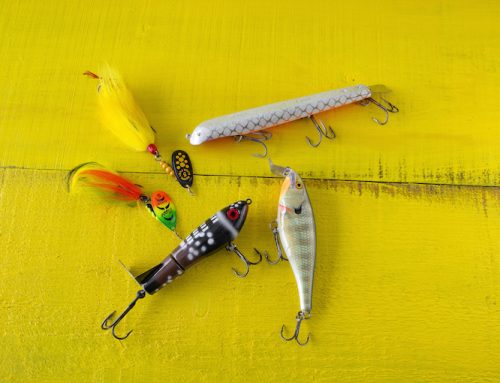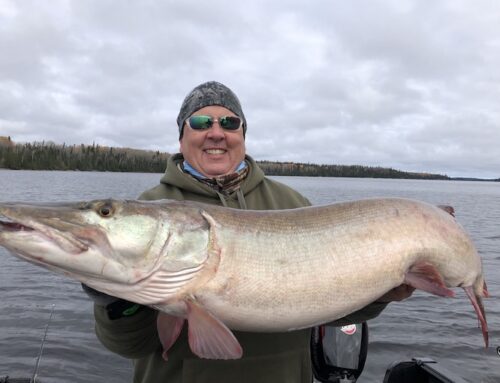
Every muskie angler I know has an impressive number of lures. This is just the nature of the game. You start with a handful — maybe a couple of bucktail spinners and a jerkbait.
In time, you add a topwater lure, Reef Hawg, a Bull Dawg or two, and so it goes. One oversized tackle box leads to two. Soon you have the weirdest array of giant lures you could have ever imagined. And the incredible thing is the variety of colour you’ll see in most of these boxes, from vivid glows to super realistic, and everything in between.
It seems there’s no end to the colour combinations we’re presenting to muskie these days, and no reason to think that will change any time soon.
It wasn’t always this way.
Black is your colour
When I began my muskie fishing career some three decades ago, my mentor was the late Russ Swerdlyk, an angler, writer, and high school teacher from Thunder Bay.
Swerdlyk was a long-time field editor for Ontario OUT of DOORS until the early 2000s. Our first conversation, back in 1986, was all about muskie fishing. I’d read one of his pieces about muskies, and being a complete newbie to the game, had many questions.
When the talk came around to colour, Swerdlyk stopped me.
“Any colour is good for muskie, Gord,” he said, “as long as it’s black.” Swerdlyk wasn’t joking. He took his muskie fishing seriously.
I was a bit taken aback by this. I’d fished for other species long enough to know that colour was a thing. We used red and chartreuse for steelhead; yellow was the go-to colour for walleye jigs; and orange was standard for brook trout. Black was not a common colour for anything, except maybe a nymph pattern.
That summer I travelled with Swerdlyk on a muskie fishing adventure to Sioux Lookout where we fished both Big and Little Vermilion lakes and he proved how serious he was about black lures.
He had Suicks, Tally Whackers, Muskie Jitterbugs and a couple of other things I’d never seen before or since, and they were all jet black. Even his bucktail dressings were black (although the blades were fluorescent red, the exception that proved the rule).
Yet the black fixation worked for him. Swerdlyk caught a lot of muskie on his black lures and his then-young muskie fishing protege followed suit. For many years, most of the muskie lures I bought were black, or ended up that way thanks to a paint brush.
Be a “Believer”
Eventually, I met more muskie anglers and their colour palettes were generally a little broader than Swerdlyk’s. When my buddy, Bill Friday of Kenora, began to fish muskie he quickly loosened up with his lure colour selection.
At first, it was just more natural-looking finishes, like red sucker or walleye. Then he discovered colourful options, like bumblebee, clown, and chartreuse, and added them to his arsenal of Believers and Grandma baits.
At some point, Friday discovered he could have his favourite trolling lure, the Believer, custom painted. I found this out one September morning when he dipped his hand into his massive Plano tackle box and pulled out a glistening, cherry-red lure with metal flake.
“What the heck is that?” I said to my friend, who was positively beaming with pride.
“It’s a Spinda Believer,” he replied, holding it up to the sun. “They use gel coat, like on bass boats, but they are $65 bucks each, so I better stay clear of the snags.” Keep in mind, this was 25 years ago, when $65 was about three times the cost of a regular Believer.
This story would not be nearly as interesting if Friday hadn’t caught some absolute monsters on his tricked-out and colourful Believers. One of the best fish he caught, if memory serves, was 54 inches long.
Sadly, the cottage water lines and pre-Cambrian rock of Lake of the Woods slowly stole Friday’s Spinda Believers away. That spelled the end of that era.
 Orange is the new black
Orange is the new black
The colour bug bit me hard in the early 1990s and I began collecting brightly coloured lures. In particular, I remember a fluorescent red-jointed Believer and a 10-inch orange Suick that was immediately dubbed the “Great Pumpkin.” Both of these lures looked absolutely unnatural and were as far from black as you could ever get.
The Great Pumpkin was given a lot of water time. It also raised one of the largest fish I’ve ever seen. It happened over a weedy saddle on Lake of the Woods. I could see the orange Suick cruising over the weeds as I did a choppy retrieve.
Then, this enormous muskie appeared right underneath the lure. That 10-inch lure looked like a toothpick. The muskie fixed its beady eyes on all the luscious orangeness of my Suick. My knees felt like gelatin at this point, and I seriously wondered what would happen if the monster actually took hold.
However, it wasn’t to be and the giant turned and swam off. The attraction power of that orange Suick was great, but I did have trouble closing the deal.
I got a better result the first time I clipped on a fluorescent, red-jointed Believer. I was trolling northern Lake of the Woods with Friday, and we had been covering a lot of water with little to show. I’d been running Believers with more traditional colours, but decided to switch it up with the red one.
Then, near a chain of small islands, as night was about to fall, something grabbed that fiery red offering. The fish came to the surface and showed itself as large. It was tricky landing it in low light, but we brought it in.
The tape said 49.75 inches. After all these years, it remains my largest muskie.
I’m convinced that if I finally break 50 inches, the lure colour will be something decidedly oddball.
Or maybe black.






Leave A Comment